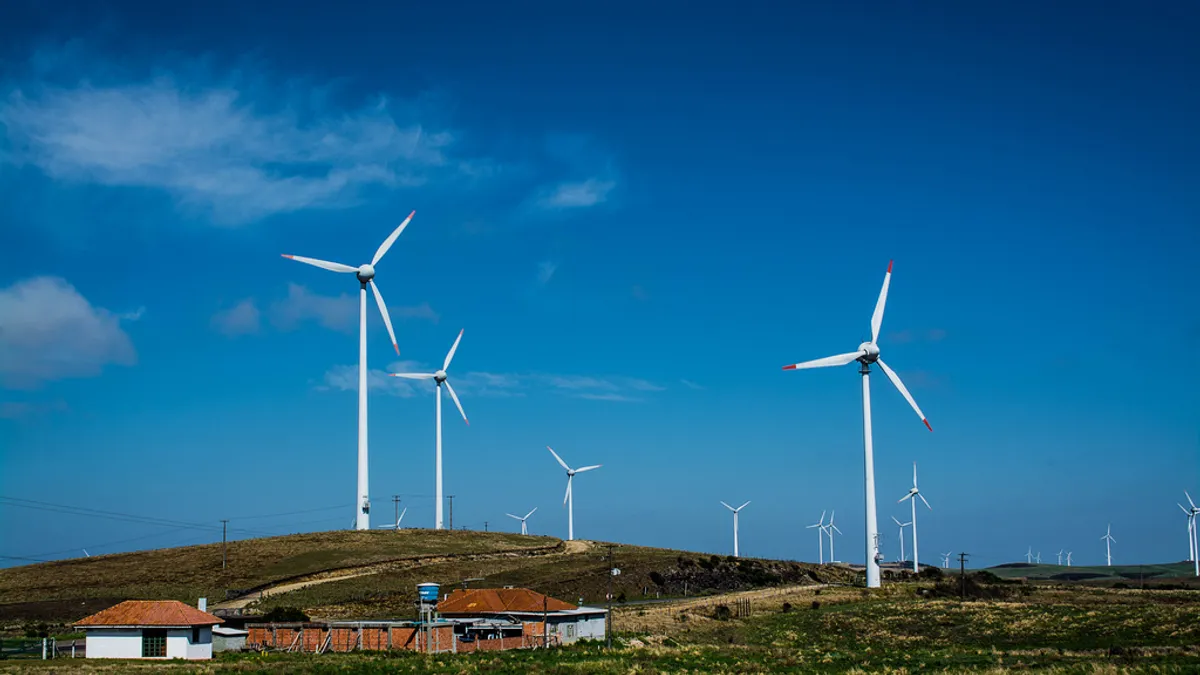Dive Brief:
- Grid operators and reliability coordinators must improve the interconnection and use of inverter-based resources on the bulk power system (BPS), or they risk disruption to electric reliability, particularly in times of extreme weather, according to a report that will be presented in August to the North American Electric Reliability Corporation (NERC) board of directors.
- Wind, solar and battery resources do not provide the same inertia as traditional synchronous generation, which can make maintaining system stability a challenge in times of grid stress. Better system forecasting and new inverter technologies can help address that challenge, according to NERC's draft Reliability Risk Priorities (RRP) report.
- There may be short-term discomfort in integrating new power technologies, but within the next decade, "I'm convinced we'll ... see the arc of a wonderful transformation towards a cleaner power grid for society," Mark Ahlstrom, vice president of renewable energy policy at NextEra Energy Resources, said Thursday.
Dive Insight:
Integrating new technology is always a challenge, and "in the short-term, it can feel like a slog," Ahlstrom said, speaking at a webinar hosted by the National Association of Regulatory Utility Commissioners.
Ahlstrom is also president of Energy Systems Integration Group and is on NERC's Reliability Issues Steering Committee. He authored a section of the RRP report focused on grid transformation, which warns that the continued integration of large amounts of new technologies, including distributed resources, storage and inverter-based technologies, "could lead to inaccurate forecasting of anticipated net demand."
"The dynamic and transient performance and response of these technologies also brings new challenges. Changing technology also has implications for control and protection systems," the report says.
NERC and the six regional reliability entities must "improve inverter-based resource BPS interconnection and operation and stay abreast of new inverter technologies," the report finds. Ahlstrom said operators must also stay on top of advances in inverter technologies, including grid-forming inverter research.
"With future adoption of technical guidelines and equipment standards, and soon with selective deployment of emerging grid-forming inverter technology when needed, inverter-based resources will make important contributions to BPS reliability during grid transformation," the report predicts.
The report is out for public comment until June 23. It will go to NERC's board of directors after the next revision and is likely to be approved in August, Ahlstrom said.
The report, informed by recent blackouts in Texas and California, also notes that "capacity alone, given the grid transformation, is not sufficient to ensure sufficient energy is available to serve consumer needs," and it recommends development of new methods and standards to address energy security.
Ahlstrom also addressed comments by NERC President and CEO Jim Robb, who in May said he has "increased concerns about the changes we're seeing on the grid and the potential consequences for reliability." California and Texas both face elevated levels of risk this summer.
Robb "makes good points," Ahlstrom said, acknowledging that system co-dependency with natural gas is a big issue, particularly following recent events.
"Diversity is good," he said. That includes diversity among new clean energy resources and between renewables and traditional generation. "I think NERC has come to a pretty well-balanced view of this, about how we're just trying to make everything work together."
The solution to a cleaner grid goes beyond the addition of nonemitting resources, said Sheila Tandon Manz, director of decarbonization planning at GE Energy Consulting.
"Bringing in the demand side is the next frontier," she said, in part because renewable penetrations are "pushing the limits of our systems."
Renewables in some areas now make up about 30% of hourly electricity deliveries on an annual basis, and they can be much more in high-penetration areas, Manz said. But adding more means electrifying, she said, which has multiple benefits.
"Electrification allows us not only to clean up all the stuff people are using ... but it gives us another lever," said Manz. "We can now put in price signals to help match up usage with all those excesses [of] wind and solar. I'm not saying it's easy, but it's the way we're going."
Better assessments of supply and demand will also be necessary, said Julia Matevosyan, lead planning engineer at the Electric Reliability Council of Texas. "One of the keys is understanding how these resources are working ... In ERCOT, we're working on producing different scenarios of what may happen, not just with inverter-based resources but [with] synchronous generation."
ERCOT, which manages the grid for most of Texas, does expect there will be sufficient generation to meet peak loads this summer. But in an attempt to rebuild trust after winter blackouts, the grid operator has also published low-probability scenarios where extreme weather could lead to blackouts. Those scenarios include unexpected drops in wind generation and thermal outages.
"Overall we're heading towards probabilistic assessments of resource adequacy," Matevosyan said.














